Coatings Based on Gelatin and Chitosan in the Conservation of Papaya (Carica papaya L.) Minimally Processed
Abstract
1. Introduction
2. Materials and Methods
2.1. Plant Material
2.2. Physical Analyses
2.3. Physical-Chemical Analyses
3. Results
3.1. Physical Analyses
3.2. Physicochemical Characteristics
4. Discussion
4.1. Physical Analyses
4.2. Physicochemical Characteristics
5. Conclusions
Author Contributions
Funding
Data Availability Statement
Conflicts of Interest
References
- Aktaruzzaman, M.; Afroz, T.; Lee, Y.-G.; Kim, B.-S. Post-Harvest Anthracnose of Papaya Caused by Colletotrichum truncatum in Korea. Eur. J. Plant Pathol. 2018, 150, 259–265. Available online: https://link.springer.com/article/10.1007/s10658-017-1265-y (accessed on 4 June 2020). [CrossRef]
- FAO. Production of Papayas: Top 10 Producers. 2018. Available online: http://www.fao.org/faostat/en/#data/QC/visualize (accessed on 4 June 2020).
- IBGE. Brazilian Institute of Geography and Statistics. Municipal Agricultural Production. 2020. Available online: http://sidra.ibge.gov.br/tabela/5457#resultado (accessed on 4 June 2020).
- Barros, T.F.S.; Rios, E.S.C.; Maia, L.D.M.; Dantas, R.L.; Silva, S.M. Fruit quality of papaya cultivars sold in supermarkets in Campina Grande-PB. Rev. Agrop. Técnica 2018, 39, 129–142. [Google Scholar] [CrossRef]
- Hewajulige, I.G.N.; Dhekney, S.A. Papayas. In Encyclopedia of Food and Health; Caballero, B., Finglas, P.M., Toldrá, F., Eds.; Academic Press: Oxford, UK, 2016; pp. 209–212. Available online: https://pt.scribd.com/document/343741472/Benjamin-Caballero-Paul-Finglas-Fidel-Toldra-Encyclopedia-of-Food-and-Health-Academic-Press-2016-pdf# (accessed on 4 June 2020).
- Cortez-vega, W.R.; Piotrowicz, I.B.B.; Prentice, C.; Borges, C.D. Conservation of Minimally Processed Papaya Using Edible Coatings Based on Xanthan gum. Agric. Sci. 2014, 34, 1753–1764. Available online: http://repositorio.furg.br/handle/1/4484 (accessed on 4 June 2020).
- Moretti, C.L. Minimal Processing Manual for Fruits and Vegetables. 2017. Available online: https://www.sisbin.ufop.br/novoportal/wpcontent/uploads/2015/03/Manual-de-Processamen-to-Minimode-Frutas-e-Hortalicas.pdf (accessed on 17 January 2023).
- Kluge, R.; Geerdink, G.M.; Tezotto-Uliana, J.; Guassi, S.A.D.; Zorzeto, T.Q.; Sasaki, F.F.C.; Mello, S.D.C. Quality of minimally processed yellow bell pepper treated with antioxidants. Semin. Ciências Agrárias 2014, 35, 801–812. [Google Scholar] [CrossRef]
- Oliveira, E.N.A.; Santos, D.C. Technology and Processing of Fruits and Vegetables. Minimally processed fruits and vegetables. Natal: IFRN. 2015, p. 240. Available online: https://proedu.rnp.br/bitstream/handle/123456789/1985/Tecnologia%20e%20Processamento%20de%20Frutos%20e%20Hortalic%CC%A7as%20.pdf?sequence=1&isAllowed=y (accessed on 4 June 2020).
- Almino, H.A.; Santos, S.C.L. Effect of application of edible coatings on minimally processed fruits and vegetables. Br. J. Environ. Manag. 2020, 14, 100–104. [Google Scholar]
- Atarés, L.; Chiralt, A. Essential oils as additives in biodegradable films and coatings for active food packaging. Trends Food Sci. Technol. 2016, 48, 51–62. [Google Scholar] [CrossRef]
- Fakhouri, F.M.; Martelli, S.M.; Caon, T.; Velasco, J.I.; Mei, L.H.I. Edible films and coatings based on starch/gelatin: Film properties and effect of coatings on quality of refrigerated Red Crimson grapes. Postharvest Biol. Technol. 2015, 109, 56–64. [Google Scholar] [CrossRef]
- Pereira, E.M.; Borges, C.D.; Formiga, A.d.S.; Junior, J.S.P.; Mattiuz, B.-H.; Monteiro, S.S. Conservation of red guava ‘Pedro Sato’ using chitosan and gelatin-based coatings produced by the layer-by-layer technique. Process. Biochem. 2022, 121, 35–44. [Google Scholar] [CrossRef]
- Wang, Q.; Cao, J.; Yu, H.; Zhang, J.; Yuan, Y.; Shen, X.; Li, C. The effects of EGCG on the mechanical, bioactivities, cross-linking and release properties of gelatin film. Food Chem. 2019, 271, 204–210. [Google Scholar] [CrossRef]
- Galindo, M.V.; Paglione, I.D.S.; Coelho, A.R.; Leimann, F.V.; Shirai, M.A. Production of chitosan nanoparticles and application as a coating in blends of cassava starch and poly(lactic acid) sheets. Res. Soc. Dev. 2020, 9, 3–15. [Google Scholar] [CrossRef]
- Freire, L.F.A.; Formiga, W.J.F.; Lagden, M.G.; de Luna, A.S.; Alves, F.D.L.; Corrêa, M.D.A.; Gil Santos, M.A. Evaluation of Textile Effluent Adsorption by Chitosan Composites. Rev. Process. Quím. 2008, 12, 9–17. [Google Scholar] [CrossRef][Green Version]
- Arnon-Rips, H.; Poverenov, E. Improving food products’ quality and storability by using Layer by Layer edible coatings. Trends Food Sci. Technol. 2018, 75, 81–92. [Google Scholar] [CrossRef]
- Hammond, P.T. Building biomedical materials layer-by-layer. Mater. Today 2012, 15, 196–206. [Google Scholar] [CrossRef]
- Richardson, J.J.; Björnmalm, M.; Caruso, F. Technology-driven layer-by-layer assembly of nanofilms. Science 2015, 348, 411–491. [Google Scholar] [CrossRef] [PubMed]
- De Paoli, M.A. Degradation and Stabilization of Polymers, 2nd ed.; Chemkeys. 2008; Volume 1, pp. 2–10. Available online: https://docplayer.com.br/3259991-Degradacao-e-estabilizacao-de-polimeros.html (accessed on 20 September 2020).
- Araújo, E.M.; Hage, J.R.E.; Carvalho, A.J.F. Compatibility of Polyamide 6/ABS Blends Using MMAGMA and MMA-MA Reactive Acrylic Copolymers. Part 1: Rheological Behavior and Mechanical Properties of Blends. Polym. Sci. Tecnol. 2003, 3, 205–211. Available online: https://www.redalyc.org/pdf/470/47013311.pdf (accessed on 20 September 2020).
- Yoshida, C.M.P.; Oliveira, E.N., Jr.; Franco, T.T. Chitosan tailor-made films: The effects of additives on barrier and mechanical properties. Packag. Technol. Sci. 2009, 22, 161–170. [Google Scholar] [CrossRef]
- Barbosa, J.C.; Maldonado Júnior, W. AgroEstat: System for Statistical Analysis of Agronomic Tests. Jaboticabal: Gráfica-Multipress LTDA. 2015. Available online: https://www.agroestat.com.br (accessed on 1 November 2020).
- Pearson, D. Laboratory Techniques for Food Analysis; Acribia: Zaragoza, Spain, 1976. [Google Scholar]
- Instituto Adolfo Lutz. Physical-Chemical Methods for Food Analysis; Instituto Adolfo Lutz: São Paulo, Brazil, 2008; p. 1020. [Google Scholar]
- Nagata, M.; Yamashita, I. Simple Method for Simultaneous Determination of Chlorophyll and Carotenoids in Tomato Fruit. Nippon. Shokuhin Kogyo Gakkaishi 1992, 39, 925–928. [Google Scholar] [CrossRef]
- Waterhouse, A. Folinciocalteau Micro Method for Total Phenol in Wine. Amer. J. Enol. Viticul. 2006, pp. 3–5. Available online: https://waterhouse.ucdavis.edu/folin-ciocalteau-micro-method-total-phenol-wine (accessed on 1 November 2020).
- Yemm, E.W.; Willis, A.J. The estimation of carbohydrates in plant extracts by anthrone. Biochem. J. 1954, 57, 508–515. [Google Scholar] [CrossRef]
- Boaretto, L.F.; Carvalho, G.; Borgo, L.; Creste, S.; Landell, M.G.; Mazzafera, P.; Azevedo, R.A. Water stress reveals differential antioxidant responses of tolerant and non-tolerant sugarcane genotypes. Plant Physiol. Biochem. 2014, 74, 165–175. [Google Scholar] [CrossRef]
- Bradford, M.M. A rapid and sensitive method for the quantitation of microgram quantities of protein utilizing the principle of protein-dye binding. Anal. Biochem. 1976, 71, 248–254. [Google Scholar] [CrossRef]
- Cia, M.; Guimarães, A.; Medici, L.; Chabregas, S.; Azevedo, R. Antioxidant responses to water deficit by drought-tolerant and -sensitive sugarcane varieties. Ann. Appl. Biol. 2012, 161, 313–324. [Google Scholar] [CrossRef]
- Abugoch, L.E.; Tapia, C.; Villamán, M.C.; Yazdani-Pedram, M.; Díaz-Dosque, M. Characterization of quinoa protein–chitosan blend edible films. Food Hydrocoll. 2011, 25, 879–886. [Google Scholar] [CrossRef]
- Lima, C.; de Oliveira, R.; Figueiró, S.; Wehmann, C.; Góes, J.; Sombra, A. DC conductivity and dielectric permittivity of collagen–chitosan films. Mater. Chem. Phys. 2006, 99, 284–288. [Google Scholar] [CrossRef]
- Gennadios, A. Soft gelatin capsules. In Protein-Based Films and Coatings, 1st ed.; Gennadios, A., Ed.; Routledge: Boca Raton, FL, USA, 2002; Volume 1, pp. 1–41. [Google Scholar] [CrossRef]
- Pranoto, Y.; Lee, C.M.; Park, H.J. Characterizations of fish gelatin films added with gellan and κ-carrageenan. LWT—Food Sci. Technol. 2007, 40, 766–774. [Google Scholar] [CrossRef]
- Poverenov, E.; Rutenberg, R.; Danino, S.; Horev, B.; Rodov, V. Gelatin-Chitosan Composite Films and Edible Coatings to Enhance the Quality of Food Products: Layer-by-Layer vs. Blended Formulations. Food Bioprocess Technol. 2014, 7, 3319–3327. Available online: https://link.springer.com/article/10.1007/s11947-014-1333-7 (accessed on 5 January 2021). [CrossRef]
- Lima, R.P.; de Sousa, A.S.B.; Abeli, P.; Beaudry, R.M.; Silva, S.D.M. Setting a safe target internal atmosphere for starch-based coated fruits and vegetables. Food Control 2022, 142, 109270. [Google Scholar] [CrossRef]
- Kumar, P.; Sethi, S.; Sharma, R.; Srivastav, M.; Varghese, E. Effect of chitosan coating on postharvest life and quality of plum during storage at low temperature. Sci. Hortic. 2017, 226, 104–109. [Google Scholar] [CrossRef]
- Fagundes, C.; Palou, L.; Monteiro, A.R.; Pérez-Gago, M.B. Hydroxypropyl methylcellulose-beeswax edible coatings formulated with antifungal food additives to reduce alternaria black spot and maintain postharvest quality of cold-stored cherry tomatoes. Sci. Hortic. 2015, 193, 249–257. [Google Scholar] [CrossRef]
- Brackmann, A.; Anese, R.O.; Both, V.; Thewes, F.R.; Fronza, D. Controlled Atmosphere for the Storage of Guava Cultivar “Paluma”. Ceres Mag. 2012, 59, 151–156. Available online: http://www.ceres.ufv.br/ojs/index.php/ceres/article/view/3799 (accessed on 28 January 2021). [CrossRef]
- Castañeda, L.M.F. Evaluation of Chitosan and Cassava Starch, Applied Post-Harvest in the Coating of Apples. Ph.D. Thesis, Federal University of Rio Grande do Sul, Porto Alegre, Brazil, 2013. [Google Scholar]
- Chitarra, M.I.F.; Chitarra, A.B. Pós-Colheita de Frutas e Hortaliças: Fisiologia e Manuseio, 2nd ed.; UFLA: Lavras, Brazil, 2005. [Google Scholar]
- Brasil, I.M.; Gomes, C.; Puerta-Gomez, A.; Castell-Perez, M.E.; Moreira, R.G. Polysaccharide-based multilayered antimicrobial edible coating enhances quality of fresh-cut papaya. LWT–Food Sci. Technol. 2012, 47, 39–45. [Google Scholar] [CrossRef]
- Lima, Á.S.; Ramos, A.L.D.; Marcellini, P.S.; Batista, R.A.; Faraoni, A.S. Addition of Anti-Browning and Antimicrobial Agents and Use of Different Plastic Films in Minimally Processed Papaya. Rev. Bras. Frutic. 2005, 27, 149–152. [Google Scholar] [CrossRef]
- Argoñosa, A.C.S.; Rapos, O.M.F.J.; Teixeira, P.; Morais, A.M. Effect of Cuttype on Quality of Minimally Processed Papaya. J. Sci. Food Agric. 2008, 88, 2050–2060. Available online: https://core.ac.uk/download/pdf/70664893.pdf (accessed on 28 January 2021). [CrossRef]
- Trigo, J.M.; Albertini, S.; Spoto, M.H.F.; Sarmento, S.B.S.; Lai Reyes, A.E.; Sarriés, G.A. Effect of Ediblecoatingson the Conser-vation of Minimally Processed Papayas. Br. J. Food Technol. 2012, 15, 125–133. Available online: https://agris.fao.org/agris-search/search.do?recordID=DJ2023049445 (accessed on 28 January 2021). [CrossRef]
- Franco, G. Food Chemical Composition Table, 9th ed.; Atheneu: São Paulo, Brazil, 1999; pp. 53–58. [Google Scholar]
- Martiñon, M.E.; Moreira, R.G.; Castell-Perez, M.E.; Gomes, C. Development of a Multilayered Antimicrobial Edible Coating for Shelf Life Extension of Fresh-Cut Cantaloupe (Cucumis melo L.) Stored at 4 °C. LWT—Food Sci. Technol. 2014, 55, 341–350. Available online: https://www.sciencedirect.com/science/article/pii/S0023643813004593 (accessed on 28 January 2021). [CrossRef]
- Besinela Junior, E.; Monarim, M.M.S.; Camargo, M.; Mahl, C.R.A.; Simões, M.R.; Silva, C.F. Effect of Different Biopolymers on Minimally Processed Papaya (Carica papaya L.) coating. Rev. Varia Sci. Agrárias 2010, 1, 131–142. Available online: https://e-revista.unioeste.br/index.php/variascientiaagraria/article/view/2655 (accessed on 28 January 2021).
- Ayón-Reyna, L.E.; Tamayo-Limón, R.; Cárdenas-Torres, F.I.; López-López, M.E.; López-Angulo, G.; López-Moreno, H.S.; López-Cervantes, J.; López-Valenzuela, J.A.; Vega-García, M.O. Effectiveness of Hydrothermal-Calcium Chloride Treatment and Chitosan on Quality Retention and Microbial Growth during Storage of Fresh-Cut Papaya. J. Food Sci. 2015, 80, C594–C601. Available online: https://pubmed.ncbi.nlm.nih.gov/25627320/ (accessed on 28 January 2021).
- Germano, T.A. Effects of Edible Coating Based on Galactomannan and Carnauba Wax on the Quality and Antioxidant Metabolism of Guavas. Master’s Thesis, Federal University of Ceará, Fortaleza, CE, Brazil, 2016. Available online: https://repositorio.ufc.br/handle/riufc/21490 (accessed on 28 January 2021).
- Boonkorn, P. Impact of Hot Water Soaking on Antioxidant Enzyme Activities and Some Qualities of Storage Tomato Fruits. Int. Food Res. J. 2016, 23, 934–938. Available online: http://www.ifrj.upm.edu.my/23%20(03)%202016/(4).pdf (accessed on 28 January 2021).
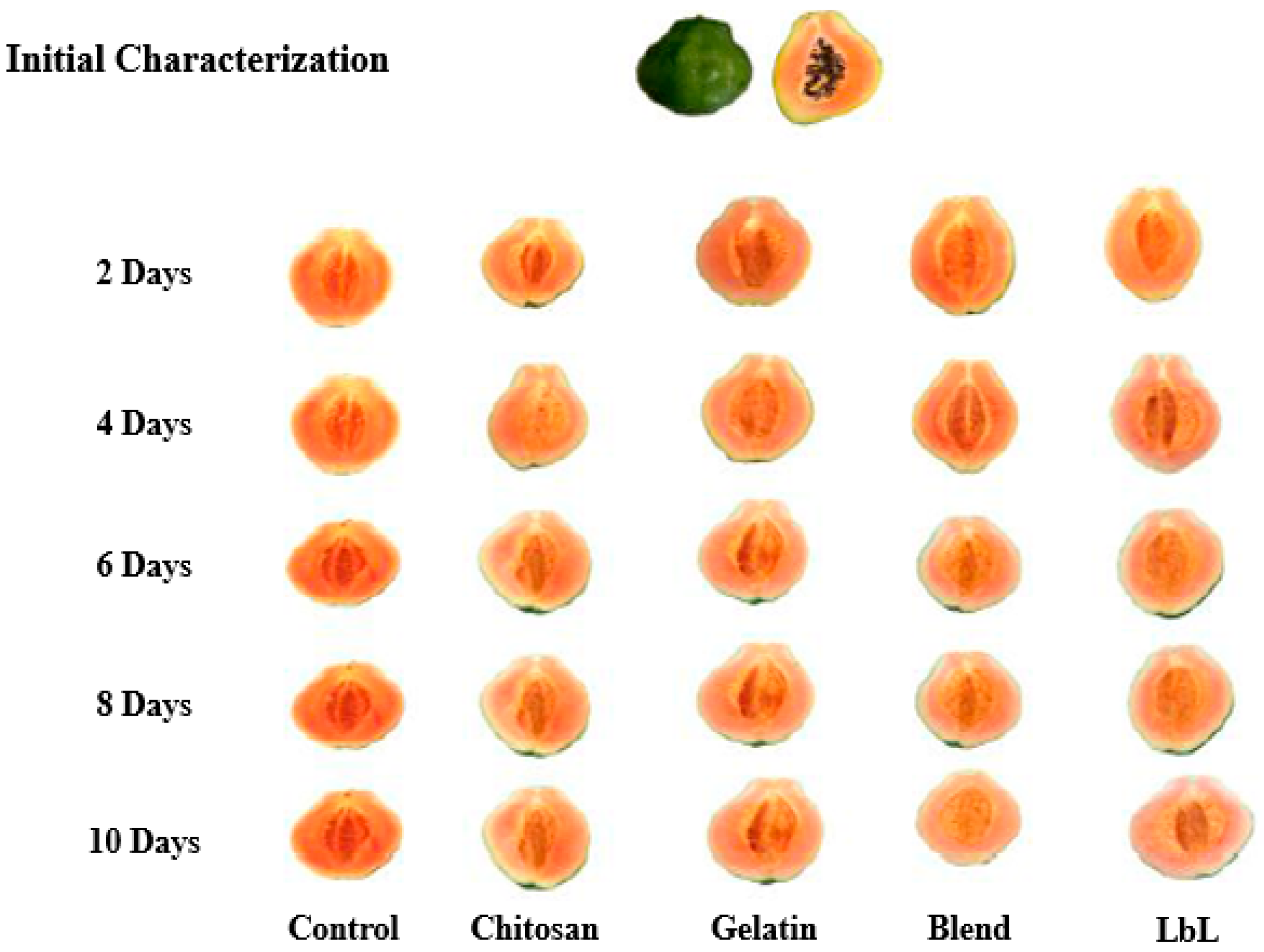

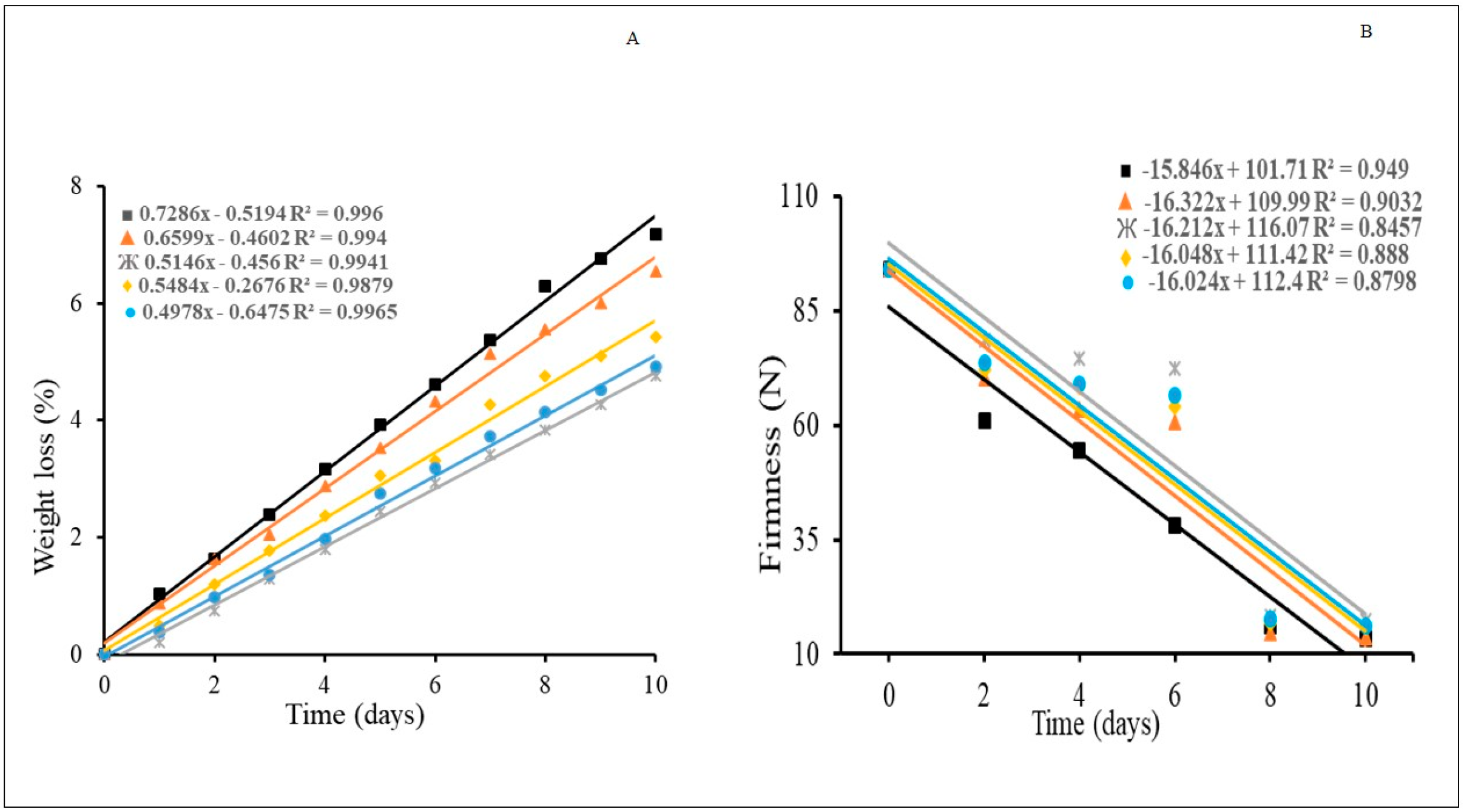
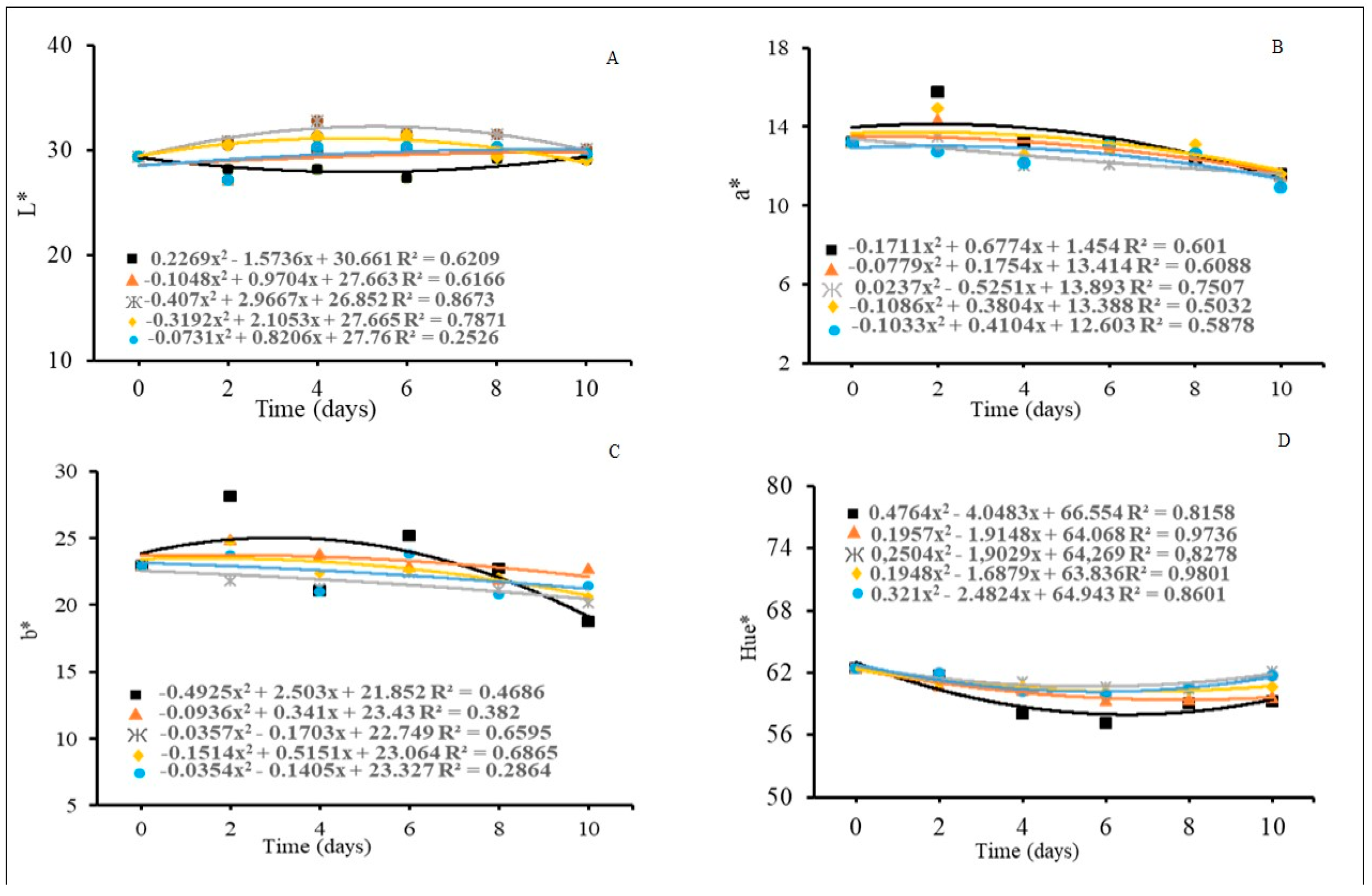
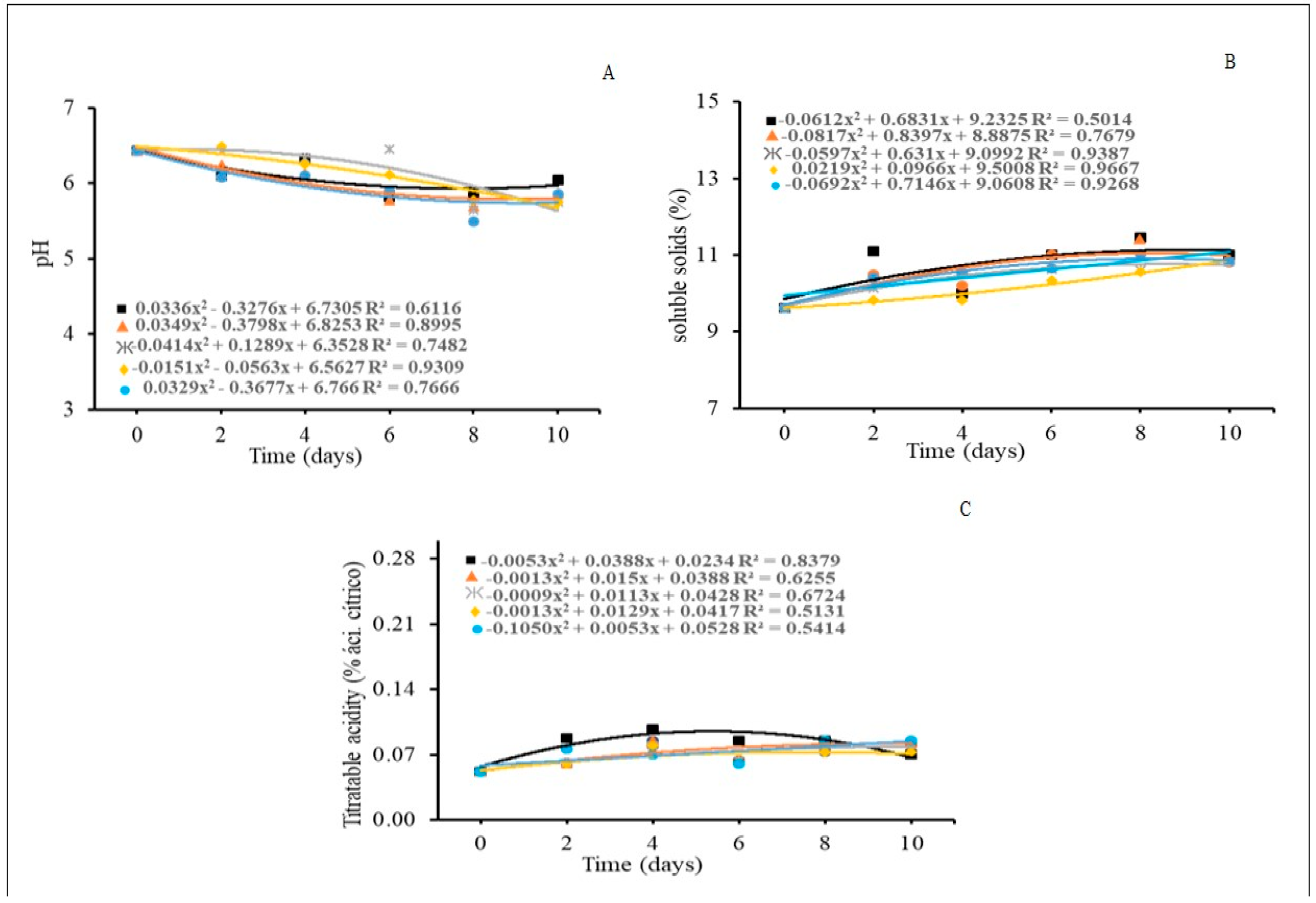

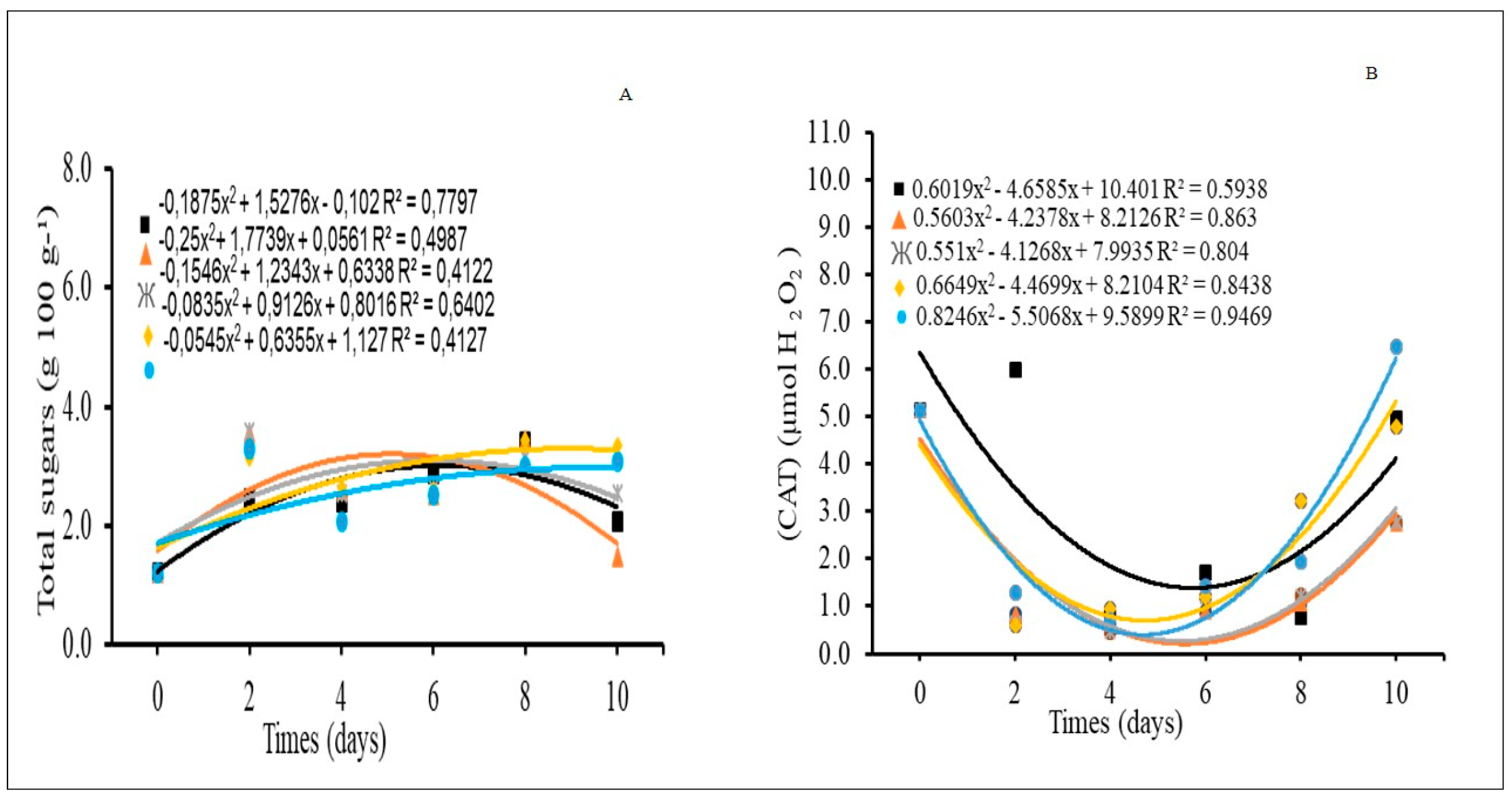
Disclaimer/Publisher’s Note: The statements, opinions and data contained in all publications are solely those of the individual author(s) and contributor(s) and not of MDPI and/or the editor(s). MDPI and/or the editor(s) disclaim responsibility for any injury to people or property resulting from any ideas, methods, instructions or products referred to in the content. |
© 2023 by the authors. Licensee MDPI, Basel, Switzerland. This article is an open access article distributed under the terms and conditions of the Creative Commons Attribution (CC BY) license (https://creativecommons.org/licenses/by/4.0/).
Share and Cite
Silva, K.G.d.; Cavalcanti, M.T.; Martinsa, L.P.; Alves, R.d.C.; Lucena, F.A.d.; Santos, M.S.A.; Silva, S.X.d.; Costa, F.B.d.; Moreira, I.d.S.; Pereira, E.M. Coatings Based on Gelatin and Chitosan in the Conservation of Papaya (Carica papaya L.) Minimally Processed. Horticulturae 2023, 9, 729. https://doi.org/10.3390/horticulturae9070729
Silva KGd, Cavalcanti MT, Martinsa LP, Alves RdC, Lucena FAd, Santos MSA, Silva SXd, Costa FBd, Moreira IdS, Pereira EM. Coatings Based on Gelatin and Chitosan in the Conservation of Papaya (Carica papaya L.) Minimally Processed. Horticulturae. 2023; 9(7):729. https://doi.org/10.3390/horticulturae9070729
Chicago/Turabian StyleSilva, Kátia Gomes da, Mônica Tejo Cavalcanti, Laesio Pereira Martinsa, Rita de Cássia Alves, Fernando Azevedo de Lucena, Max Suel Alves Santos, Samarone Xavier da Silva, Franciscleudo Bezerra da Costa, Inacia dos Santos Moreira, and Emmanuel Moreira Pereira. 2023. "Coatings Based on Gelatin and Chitosan in the Conservation of Papaya (Carica papaya L.) Minimally Processed" Horticulturae 9, no. 7: 729. https://doi.org/10.3390/horticulturae9070729
APA StyleSilva, K. G. d., Cavalcanti, M. T., Martinsa, L. P., Alves, R. d. C., Lucena, F. A. d., Santos, M. S. A., Silva, S. X. d., Costa, F. B. d., Moreira, I. d. S., & Pereira, E. M. (2023). Coatings Based on Gelatin and Chitosan in the Conservation of Papaya (Carica papaya L.) Minimally Processed. Horticulturae, 9(7), 729. https://doi.org/10.3390/horticulturae9070729






